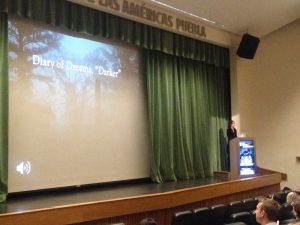In February 2019, Glasgow based author Graeme Macrae Burnet visited Edinburgh Napier to discuss his Man Booker Prize shortlisted novel His Bloody Project (Saraband, 2015) with final-year students on Professor Anne Schwan’s module “Crime in Text & Film.” Following the class, he was interviewed by English & Film student Calum Rosie.

Graeme Macrae Burnet (left) with Edinburgh Napier student Calum Rosie
Introduction by Calum Rosie:
I sat down with author Graeme Macrae Burnet to discuss his novels, his influences, and his process. Burnet told me before the interview that there was only one question he didn’t like being asked, but that he wasn’t going to tell me what it was. Read on to find out if I ask it. Or rather, how soon I asked it, because of course I asked it.
CR: I thought the first thing that I’d ask you, is a general question about crime as a genre because three of your books are centred on… that is, that is the question…?
GMB: Yes.
[both laugh]
GMB: Yeah, brilliant. But no, it’s a perfectly valid question, so just ask the question.
CR: Just what is it that attracts you to that?
GMB: Well first of all with regards to His Bloody Project, although it’s a novel about a crime, I don’t really see it as a crime novel. I just see it as a novel and I think crime fiction tends to have a certain structure, whereby very conventionally there’s a crime, a mystery, usually a murder and then there’s a journey through the narrative, whereby somebody solves the crime and that forms the narrative arc called the book. His Bloody Project isn’t really like that because we know from the beginning that Roddy is guilty of the crimes. So yeah it’s a crime novel in that it’s about a crime, but I wasn’t attracted to write that book for generic reasons; it was because I was very interested in the idea of somebody who has committed these very violent acts being able to write an articulate account of the events leading up to the murders, and as I was discussing earlier this idea from the French case of Pierre Rivière. My other two books, they are crime novels and they are certainly within the crime genre, but I think they kind of play a little bit with the expectations of the genre, the expectation generally being that when you get to the end of the book the crime will be solved.
CR: Yeah.
GMB: And you will be returned as a reader to a sort of position of certainty and knowledge and to some extent neither of these two other books, The Accident on the A35 and the Disappearance of Adèle Bedeau, really fulfil the expectation of the genre. What I’m most interested in, in both these books and in His Bloody Project, is the psychology of the characters. So in the Disappearance of Adèle Bedeau it’s a disappearance first of all; it’s not a crime. There is no crime.
CR: Yeah in the end there is no crime really at all.
GMB: Yeah so it is a crime novel even though there’s no crime in it; the central event is not a crime. And The Accident on the A35 – it’s an accident. But these events are a springboard for me to explore the characters who are involved in the events and that’s what interests me most. I mean The Accident on the A35 has a structure just like a crime novel, and there are actually two investigations going on, one by the cop Georges Gorski and one by the son of the deceased, Raymond Barthelme, who are both trying to find out what happened on the night of the death of the father, so there’s a crime novel structure and bizarrely it’s not necessary for there to be a crime. So yeah I’m kind of interested in generic expectations, but I think they are sometimes there to be played with as well. Sometimes really hard-core readers of crime fiction don’t respond that well to my books, because they don’t fulfil the normal expectations. They’re just really slow. [laughs] Nothing happens.
CR: Especially in The Accident on the A35 there’s this subplot of the strangling in Strasbourg and in any other novel that would probably be the main thread.
GMB: Yes, absolutely, I mean that’s there to draw Gorski the cop in a certain direction, but that’s a kind of dramatic crime novel murder but I’m not really interested in it and we’re not really interested in who committed that murder. It’s there again because it takes Gorski into a sort of a subplot with the big cop Philippe Lambert from Strasbourg, where he feels out of depth and he gets into these scrapes, and goes to the sleazy bar you know, humiliates himself and misses a date with his wife. See I’m more interested in Gorski’s relationship with his wife than whether he solves this crime or not. So you’re right it’s very much a sub plot.
CR: You mentioned early on that the I, Pierre Rivière dossier was sort of central. What did you think about the way Foucault and colleagues responded to it?
GMB: Well I read the book in full back in 2012 and I didn’t reopen it, because it did have a central role in His Bloody Project, but I didn’t want to replicate it. So my memory of the surrounding documents are pretty sketchy to be honest, but what I remember is the competing discourses trying to make sense or create meaning from, but basically to interpret this text from Pierre Rivière. What was the meaning of the text? What is the meaning of the text in relation to the murders? Does it change the nature of the murders because the murderer is capable of writing this account? Does it change it in a negative way or positive way? My sort of overriding memory of the book was the dossier format of the book, and that’s what had the influence on me, to create a book where there are different documents and the reader can kind of come to their own conclusions about what’s been going on.
CR: How did you feel about the conclusion that I think in particular Foucault came to; he seemed like he was admiring Pierre in a way. At one point they almost try and compare crime to art. Do you think that is problematic in any way?
GMB: Yeah well, Foucault was a very creative thinker I think. You know, I am a fan of his or at least some of his work, but I don’t think you need to read Foucault and say “Well this is what Foucault said, so Foucault’s right”. I think Foucault’s a creative thinker, and sometimes he writes stuff and it makes you think. So if he compares a murder to a piece of art, that’s an interesting thought. It doesn’t mean that you have to endorse that thought, but what would it mean to think about a violent act in the same way you would the creation of a work of art. By having those thoughts it’s stimulating, but you don’t have to endorse the idea. Foucault wrote some pretty odd stuff. There’s a thing in Discipline and Punish about the scaffold and the spectacle and I think, sometimes it’s better to say something reasonably extreme and seemingly black and white because it’s interesting to say it. And if you hedge too much and qualify everything, you end up saying nothing. So in a way, Foucault is being a polemicist and that’s probably why we are still reading him and talking about him. I mean I’m not a fan of Freud; Freud was full of shit.
CR: I’d agree.
GMB: But Freud was also an amazing creative mind and you could read him as literature and read him as a character and you know some of his later work, you know Civilisation and its Discontents and so on. I find it really interesting, which doesn’t mean I think it’s the truth. I don’t believe in the Oedipus complex but it’s interesting to read that stuff as literature. So I feel pretty similarly with Foucault.
CR: So kind of following on from that, you mention the death of the author, interpretation as being key; was that one of the reasons that you, in your three books you’ve kind of presented them as… in two of them, you’re a translator, was that a way to distance yourself?
GMB: Well, with the first book, The Disappearance of Adèle Bedeau, yes, I claim to be the translator, and the author of the book is Raymond Brunet, a French author who was born and brought up in Saint-Louis and wrote this autobiographical novel. And what happens is Raymond Brunet, he dies;, he commits suicide. So it is death of the author, in the book.
CR: Oh, right I see.
GMB: But yes, absolutely, it’s a great question. So what we’re doing there is, because the book, Adèle Bedeau, contains a short biography of the author, so I’m kind of inviting the reader to play that game whereby they interpret the text in relation to the life of the author. Which is not the same as the intentions of the author; that’s another strand of that very traditional approach to literature, biographical criticism. I’m now making a yawning gesture! So yeah I’m very much playing with the idea of interpreting the text in relation to the life of the author by presenting this fictional author and, when the book came out in 2014, I was obviously completely unknown and the book came out with no fanfare, small publisher. And I went down to London to sign some copies in shops, and the booksellers there, they all thought it was a French novel, written by Raymond Brunet.
CR: Oh really?
GMB: So when I went into a small bookshop in Primrose Hill and the manager greeted me with the words “Ah, the translator!”
CR: [laughing]
GMB: I was like “Eh, yeah, haha.” And he was like “Yes, isn’t it amazing how the life of the author paralleled the life of the characters in the book?”
CR: Oh dear.
GMB: And I suddenly realised that, you know, there’s no reason for people to disbelieve this. I hadn’t intended to trick anybody, but people felt that they had been tricked. And that’s really interesting because, when we read a novel, we are tricking ourselves. We are engaging with a fictional character. We’ve been having a conversation about Roddy Macrae and whether we empathise with him; we follow his journey. He’s not real.
CR: Yeah.
GMB: And you know, His Bloody Project is kind of the opposite of these other two books in the sense that I present it as a real case, and I go to great lengths to make it seem real, and probably fifty percent of readers think it’s real.
CR: My mum did, actually.
GMB: Yeah.
CR: I spoke to her last night saying I was going to do this, and she said “Oh yeah, cos he wrote about the thing that happened,” and I was like “Oh no, it didn’t happen.” And she got really annoyed actually.
GMB: Yeah!
CR: She was like “So he lied about it?”
GMB: Yes!
CR: And I thought, in as much as anyone who’s ever written any story ever, yeah I suppose he did. [laughs]
GMB: But that conversation is exactly the conversation I’ve had about… “So it’s a lie?” All fiction is a lie. And I’m drawing attention to that by presenting my fiction as non-fiction. People sometimes react just like that, as your mum, they’re annoyed. They feel like they’ve been duped. And it’s made me reflect on what we’re doing when we read fiction, and the relationship between fiction and non-fiction, and I find it all very interesting.
CR: I was wondering what, was that part of the reason, because both of your fictionalised authors share one of your names, or similar in a way, because there’s Roddy Macrae–
GMB: Oh yeah.
CR: And Brunet which is very similar to…
GMB: Well it’s an anagram. Sorry, is it deliberate?
CR: Yeah, was that kind of…?
GMB: Well, with Raymond Brunet it’s a deliberately obvious anagram. And yet, because of the French pronunciation, Brunet sounds quite different from Burnet. There are only two letters swapped around, but Brunet is a very easy French name. So, surprisingly, most people don’t notice. So that was, you know, an anagram making it obvious that this is fiction, and he’s also me, sort of thing. With Roddy Macrae, the set up at the beginning of the book is that I’m looking for some historical, some family historical records of my grandfather, whose name was Macrae, so it would be logical that within that, I would come across a document by another Macrae. So that was really the reason, I wasn’t trying to, you know he’s not my doppelgänger.
CR: Did you ever consider passing Roderick off as a member of your family, or were you a bit reluctant to?
GMB: Well I did, actually; originally, my intention was that the book, because Roddy’s mother in the book dies of childbirth and the offspring from that birth was taken away and taken care of by extended family in Toscaig. It’s alright, nobody remembers that.
CR: [laughs]
GMB: So I was going to pretend that I was the offspring of this other son, so Roddy would have then have been my great-great-great-great uncle, I think. But I decided, A) it wouldn’t have added anything to the book and B) I would have had to ask everybody in my family, “Would you mind if I create this character who is a triple-murderer, from the same part of the country as us, and then say he’s actually part of our family?” And I couldn’t, as I say it wouldn’t have added anything to the book so there was no point. But funnily enough though yes, I did think about it. [laughs]
CR: I actually know some Macraes from up sort of Inverness way.
GMB: Oh yeah? Oh right, well it’s certainly a pretty common name; you know Wester Ross where my mum’s from, Macrae and Mackenzie are the biggest names. There are so many Mackenzies up there. But I think that’s why there are so many nicknames, to differentiate between different–
CR: Of course.
GMB: You know, there’s no point saying “Roddy Macrae” because there are so many Macraes. I mean if I’d been really realistic in the book, there would have been more Macraes and Mackenzies. But in a novel you can’t do that, because you’ve got to differentiate people by name.
CR: And on the subject of that actually, you write a lot about, small, kind of provincial towns. Do you have any sort of experience with that, or is there a reason, or has it just happened to…?
GMB: [laughs] Well, I mean I come from Kilmarnock, which I guess is a small provincial town, and when I was growing up I certainly had a strong desire to leave Kilmarnock. And it’s nothing against Kilmarnock, particularly; I think I would have felt that way whether I’d been in Motherwell, Hamilton, Ayr, Dunfermline, Inverness or wherever. It was a desire, which I think is a positive thing as a teenager, to go elsewhere. And so Saint-Louis, the small town in the French novels is a real place. And I just happened to visit there, around 2000, and I went to the restaurant in the novel, and I had lunch.
CR: Oh really?
GMB: And that’s where the novel arose from that moment of inspiration, observing what was going on around me, the sense of routine, the sense of a very unremarkable town. The feeling that if you grew up there you would have this desire to escape, so in some ways I was projecting my own feelings onto this other place. I mean the way I’ve written about Saint-Louis is really unfair! [laughs] Because I’m very rude about that town.
CR: But I think you say in the afterword that it’s not justified; you kind of bring it back.
GMB: Well spotted! I did, because when I wrote the second book, I went back to do some research, and the first couple of times I’d been to Saint-Louis, it was the middle of winter and it was really grey and horrible. And when I went back to do research for The Accident on the A35, it was June, and it was 35 degrees, and there was blossom on all the trees and it was sunny, and people were sitting outside, and actually the town seems quite nice. But because I was written within the persona of Raymond Brunet, who was himself trapped in the town, I couldn’t then suddenly be nice about the town. Hence in the afterword to The Accident, I say “Saint-Louis is by no means as unpleasant Raymond Brunet says it is!” And I’m really glad I wrote that because, bizarrely, there’s a literary festival in Saint-Louis.
CR: Oh really?
GMB: And because it’s a fake translation into English, the book’s now been translated into French. Or back into its original language.
CR: [laughs]
GMB: And actually, so The Disappearance of Adèle Bedeau has come out in France; I think there seems to be quite a lot of curiosity about why some Scottish guy wrote this book, which is very heavily influenced by Georges Simenon. So the books actually had quite a lot of attention in France, and I’m going to go to the festival to appear and answer for why I’ve been so rude about this town. So that will be an interesting experience.
CR: Just take a couple of pages where you’ve said nice things about them.
GMB: Yes absolutely, I’ll get it on a t-shirt: “I love Saint-Louis.”
CR: Yeah that’s a good idea.
GMB: I’ve probably done something for their tourist industry.
CR: Oh I’d think so, yeah. I’d go there.
GMB: I think, just to back to your actual question, I have a fascination with slightly unremarkable places, and I think when you’re an outsider in a place, as writer, that’s a far more productive experience. If I’m in a bar in Glasgow, I’m with my friends; if I walk around Glasgow, I don’t notice anything. But when you’re alone, abroad, maybe your grasp of the language isn’t great, so that’s kind of filtered out, I find that your powers of observation are much more heightened. And actually when I went back to the research for The Accident, this was an act of deliberate observation. If you sit in a bar, or a cafe or in a park for an hour, without your phone, without a book, without a newspaper, that’s actually quite a long time, and you see stuff. And stuff that I observed went straight into the book, and helped to shape the texture of the book, so I think people think it’s very odd, and it is odd, to have written two books about this town in France, not being French myself, but it’s that feeling of outsider-ness, which I think is really important for writers.
CR: So was Saint-Louis one of the inspirations for the story or was it just a place that happened to fit?
GMB: No I went there, I went for lunch in what becomes in the book the Restaurant de la Cloche. The original idea for the book would be that it would be entirely set in the Restaurant de la Cloche. That was too restrictive. So when I was there, there was a character who was in the restaurant, very traditional French bistro, everybody goes there for their lunch, you know office workers, people from the building site, just go in and have a three course meal and a glass of wine. Love France for that! And there was a guy at the bar, and he was wearing a suit and looked ill at ease, and uncomfortable, and I felt, he comes here every day, and these other people come here every day and they never speak to each other. There’s all these unspoken tensions. I wrote a sketch of the scene; this was about fifteen years ago, and it always stayed with me. And all I did, I took that, I started writing. I created the character of Adèle Bedeau, who’s the waitress in the restaurant, and then she disappears, and that’s the springboard event to examine the lives of the characters. And I knew nothing more, when I started writing, than that. So I just built it up as one event begets another, and then you find the characters. I knew who the character of Manfred Baumann was from the beginning, because I share some of his neuroses.
CR: Not all of them I hope.
GMB: Not all of them yes, just to be clear!
CR: I’ll put that in the official record. So what is it that made you want to start really writing it, as opposed to, I think you said you worked in television for a while?
GMB: Well I’d been writing since I was a student at Glasgow University, off and on, short stories. I’d finished writing what I would call a straight crime novel, in the nineties. It was set in a version of Kilmarnock and it was called Hard Rain. You know, proper crime novel title. But you know, I finished it and that’s an achievement. You know, get to the end. It’s easy to start. And then in the interim, I’d started about three or four other novels and got to maybe thirty-thousand words or something, and given up. And somehow this scene in this French town has just stayed with me. I mean, it was definitely ten years between starting to write the novel and being there. So, I remembered it, utterly crystal clear, but when I went back to the place, ten, twelve years later, it was exactly as I remembered it, and I had this feeling that nothing ever changed there, and what I loved was when I went back twelve years later, I had exactly the same lunch. The menu hadn’t changed!
CR: Oh wow, yeah.
GMB: So you know, I went back to it because it stuck in my mind, and I’d had these failures, if you want to call it that, or unfinished novels, and I played a little trick on myself. Actually I got made redundant from my TV job, which was good.
CR: I just got made redundant recently actually.
GMB: Oh congratulations. That’s a good life experience. And I thought right, time to write a novel Graeme, get on with it, and for some reason I plomped on that. And I told myself I was writing a short story. Just a little mind-trick. It’s like “It doesn’t have to be a novel. It could be twenty-thousand words; it could be a novella.” And because I read a lot of Simenon and other European crime fiction, and a lot of that stuff is maybe fifty-thousand words. There’s a much bigger tradition of the short, very brief crime novel. So I was kind of aiming for fifty-, sixty-thousand words, which is a more attainable goal than eighty-, a hundred-thousand words, especially when you’re starting. Maybe you’re writing yourself?
CR: A bit, yeah.
GMB: I kind of played a trick. I loved the world of the book, you know; I loved it. And I found it very easy to write the character of Manfred Baumann. I struggled with narrative; I still struggle with narrative, but I enjoyed the milieu, and that’s why I wrote the second book, because I wanted to go back to that milieu, and just be in it again.
CR: Are you planning to go back to it?
GMB: There will be one final book featuring Georges Gorski. If you remember at the beginning of The Accident, two manuscripts are delivered to the offices of the publisher.
CR: Oh, of course!
GMB: But I’m not interested in writing a series. Publishers loves series. You know I killed the author. Sometimes the big mistake of crime writers is to kill off their character, but I actually killed the author of the books. So there was a certain amount of contrivance in writing the other book, but again The Accident is far more of Raymond Brunet’s book, because it was about the death of his father, and he is writing a fictionalised account of this fictional event. Then I’m inviting the reader again to interpret how much of what’s in the novel was “true” to Raymond Brunet’s actual biography which is, of course, also fiction. I have real trouble explaining this.
CR: It makes sense when you read it, yeah.
GMB: So that’s all fun. And I think that it adds a little layer. Some readers find it a little bit unnecessary, pretentious, but that’s fine, you don’t need to read it and I enjoy it and I think it’s fun, and as a reader it’s the sort of thing I would like.
CR: Yeah, definitely. Because when you’re reading, and I think you mentioned this earlier, you don’t want to fall into the trap of “What’s the author trying to say; how much of this is true?”. These kinds of books almost let you do that, without doing it, if that makes sense.
GMB: Well, you’re invited to relate the text to the life of Brunet. And you used the phrase – you asked me earlier if I was kind of stepping back. And I suppose yes, absolutely, all the books I’ve written so far, the text has been presented as having been written by somebody other than me. And to let you into a secret, without having thought it through, I’m doing the same with my current book. So obviously there was something going on there. Obviously I’m a really shy, anti-social person.
CR: [laughs] Maybe that’s it, yeah.
GMB: But again, as we were discussing in the class, you don’t necessarily analyse everything before you do it, or do it for a rational reason. Sometimes you just do stuff because it appeals to you, or you’re going with the flow, then afterwards people expect you to have a rational explanation, and that’s not the way I work.
CR: I guess we’re taught as students to always assume that there is a reason, but there often isn’t.
GMB: Well, if you talk to twenty different writers, you’ll get twenty different answers, in terms of to what extent. Some writers set out to “explore a theme.” [he makes a vomit face].
CR: [laughs]
GMB: And that’s not the way I do it. I hate the word “theme,” but that’s something that can come out as a matter of interpretation after the text is in existence. I think for me, if I wanted to explore a theme, then I would create characters who represent different aspects around that, and my fear would be that it would be schematic, and I wouldn’t have those moments where I feel emotional engagement with the character. Because I think when we read novels, and I think it’s amazing that we are still reading novels in the world we’re in, I think people predominantly read novels because of character, and it’s character that draws people into the narrative and makes people care about the book. And so you can have all the intellectual ideas you want, but if you’re not engaging a reader on the level of character, or on the level of story maybe, then nobody’s going to finish the book. So I kind of approach it form the bottom up and if there are interesting conversations to be had afterwards, you know it’s like “oh yeah yeah, I see what you mean. Oh providence, yes!”
CR: Yeah of course, yeah.
GMB: But sometimes an idea will arise during the writing of the book, like the idea of providence that we were discussing earlier. And you might see it reappearing in some way and you might draw that out a little bit, I would say. But I don’t want to start by thinking I want to push something, on a rational, intellectual level. I want, first and foremost, very old fashioned, I want emotional engagement.
CR: So can you tell if you’re reading another book, can you be like “Oh I see they’re trying to talk about the issues”?
GMB: Well I mean yeah, it’s called bad writing.
CR: [laughs]
GMB: I mean a really obvious way that you might come across that is if you feel that the author is putting words into the mouth of their character, they’re making a little speech about something, and you feel that it’s not motivated by the character. So yes, I would say that I can tell. And I think that most people could. You know, I’m a reader, just like you’re a reader, just like anybody who reads novels is a reader. Maybe as a writer I’m a bit more aware of the techniques that people use. I’m not sure that’s true, but I think the last thing I want from a novel, or any piece of art, is to feel that the creator of that work is hitting me over the head with making their meaning overly obvious. I love Georges Simenon because Simenon never judges his character. He describes the action and locations, but it’s very much for you to make up your own mind. But if you read somebody like Emile Zola, you’re always aware of what Emile Zola thinks of his characters’ behaviour.
CR: [makes a scoffing noise to pretend he knows about the writing style of Emile Zola]
GMB: He’s a moralist. And he writes in terms where he will be condemning of their vulgar, depraved behaviour. I mean I like Emile Zola, it’s great stuff, but there’s a difference; you can see that Zola, the moralist, had a moral drive in his books that Simenon doesn’t. So I prefer the Simenon method.
CR: You see that kind of moralism a lot? Do you ever read or watch any true crime stuff?
GMB: Well, I used to read quite a lot of true crime. But I think with non-fiction it’s slightly different. It just depends on the writer. I mean I like reading non-fiction and I would like to write a non-fiction book one day. An actual non-fiction book.
CR: Do you think people would say “Hang on, is this one actually real, or…?”?
GMB: Well, that would be really fun though, wouldn’t it? I was reading this little book by a philosopher; I’m not a big philosophy reader, but I was reading this book about suicide, and he tells this story about this 14th century Italian guy who’d written a treatise on suicide. And because of my way of thinking, I was like “I wonder if he’s just made this guy up.” I could go and google him, and with His Bloody Project, many people have googled characters in the case. And in fact, with the French books, people go away and google Raymond Brunet, the author. And what’s bizarre is, a friend of mine made a trailer for the alleged film.
CR: Oh really?
GMB: Which is online. So that muddies the waters even further.
CR: That’s really funny.
GMB: The trailer is obviously fake, but it’s very well done. So yeah look it up.
CR: I will do; that’s really cool. Do you have any tips for anybody who wants to get into writing?
GMB: Yes. Stay the fuck away from all these books about creative writing. Stay away from the tips. I see a lot of it on social media, and I totally understand when you’re beginning. I’ve been there, but I think these endless lists of tips for writers, they drive me up the wall. I mean I avert my eyes. Because once you’ve read them, you can’t unread them. They stick in your mind, “Do this, do that, do it this way, don’t do it that way.” I’d say: read a lot, re-read. It’s much better to know one book well than to have read ten books in a superficial way. And there’s no substitute for the actual writing. I get asked at every event I do, at the end, someone asks, and I can see them, they’re shuffling all shy, and I say “Aw are you a writer; do you write?” “Aw yeah a bit, you know.”
CR: [laughs] Exactly what I said a minute ago.
GMB: Yeah, totally. And I understand that, we’re Scottish! And I say “What are you working on?” And they say: “Oh I haven’t started, I’ve just been thinking about this,” often for thirty years. And I’m like “Go home and tomorrow, write a thousand words.” Because if you can’t do it, you can’t do it. There is no substitute. A lot of people who are “stuck,” they say they have a desire to write; they’re the ones reading the books on creative writing. I’m not saying there’s no place for that sort of stuff, but on the other hand, I was forty-six before I published a novel. So a lot of people go “Oh my god, that’s ancient.” It’s actually about average. So you have to find your own way, absolutely, and that’s why I’m sceptical about prescriptions about how you should write. I mean I have my own proscriptions, or prescriptions, about how I go about stuff. I’m very, very strict on point of view. I will never violate point of view in my novels.
CR: Yeah.
GMB: And that’s me. I’ve just read Jacqueline Susann’s Valley of the Dolls. Wow! It’s amazing; one of the biggest selling novels of the twentieth century. It’s a real door-stopper, pulp fiction kind of story, but it’s amazing. And she doesn’t care about point of view. She can enter the head of any character at any point. So that’s fine, but if you set up the rules, you’ve got to follow the rules.
CR: Yeah, because in yours, it’s Gorski, plus Manfred.
GMB: So you never know what any other character is thinking because we only ever see them through either Gorski or Manfred’s eyes. So I use the phrase “as if” a lot. Because, “as if they were doing,” because we don’t know.
CR: Oh right, yeah.
GMB: So yeah. But you just got to be doing some writing. Write stuff, throw it away. Be prepared to throw a lot away. I mean people say “Oh, I’d like to see that earlier novel you wrote” and I’m like “Yeah, no chance.” But it was a great learning experience.
CR: And you’ve got a new one in the pipeline?
GMB: I’m working; I’m getting towards the end of the first draft.
CR: Okay so a wee while yet.
GMB: Yeah, 2020 at the earliest. But yeah I just want to make sure it’s as good as it can be. It’s a struggle. But I always struggle; I struggle with narrative. Putting things in the right order seems simple, but it’s difficult for me.
CR: I guess then my last question is, if someone were planning to write an essay at university on His Bloody Project, where would you recommend they start?
GMB: I would say, read the text. The book is the text, that’s all that matters. Don’t listen to interviews with the author.
CR: [laughs]
GMB: Everything required to write an essay about any book is the book. If you’re writing an academic essay, you are required to read and cite previous sources, that’s the game, that’s fine. I don’t know how much, if anything, has been written about His Bloody Project. But I’m a big fan of primary sources as well, as a researcher. So I would say it’s more important to go and read articles about James Bruce Thompson, or go and look at some documents relating to some real life murder cases. Read the style of writing that was prevalent at the time. Read about the history, the way of life at the time. I would say reading around the subject raised by the book. There probably isn’t much criticism. You’ll know better than me if there is any. I mean the novel’s only three years old.
CR: Yeah that’s the difficulty with writing about recent things.
GMB: You should see it not as a difficulty but as being a liberation; you don’t have F. R. Leavis looking over your shoulder. Or another hefty literary critic. You can just come to your own view.
CR: When you were a researcher, did you ever have difficulty in deciding when the research stopped? And finding the balance there?
GMB: That is a difficulty. I read a novel relatively recently where the person included far too much of their research in their novel, where it was completely not motivated by the story or the characters. So it’s like, yeah you’ve done your research, you’re just showing it off. I tried to be careful with that in His Bloody Project. For example, earlier I was talking about these superstitions I came across in research. Absolutely fascinating and anybody you talk to, they go “Wow, that’s amazing,” and I’d written bits where I’d contrived use of those superstitions; I’d sort of shoe-horned them into the story. And I read it back over and I knew I’d only written it in because I’d done the research, and that’s the wrong way round. So you have to start writing at some point. The thing I’m writing at the moment is set in 1960s London. I could do endless research, but I’m at the point now where I’ve been writing and my research will be more of the kind of, not fact-checking, but I just need to find a little bit. It’s a very directed research, rather than general finding out about the milieu, kind of research. So it’s a bit of back and forth.
CR: Thank you very much, Graeme.
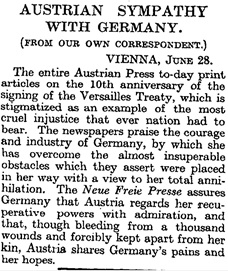


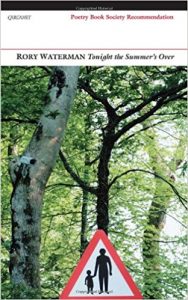



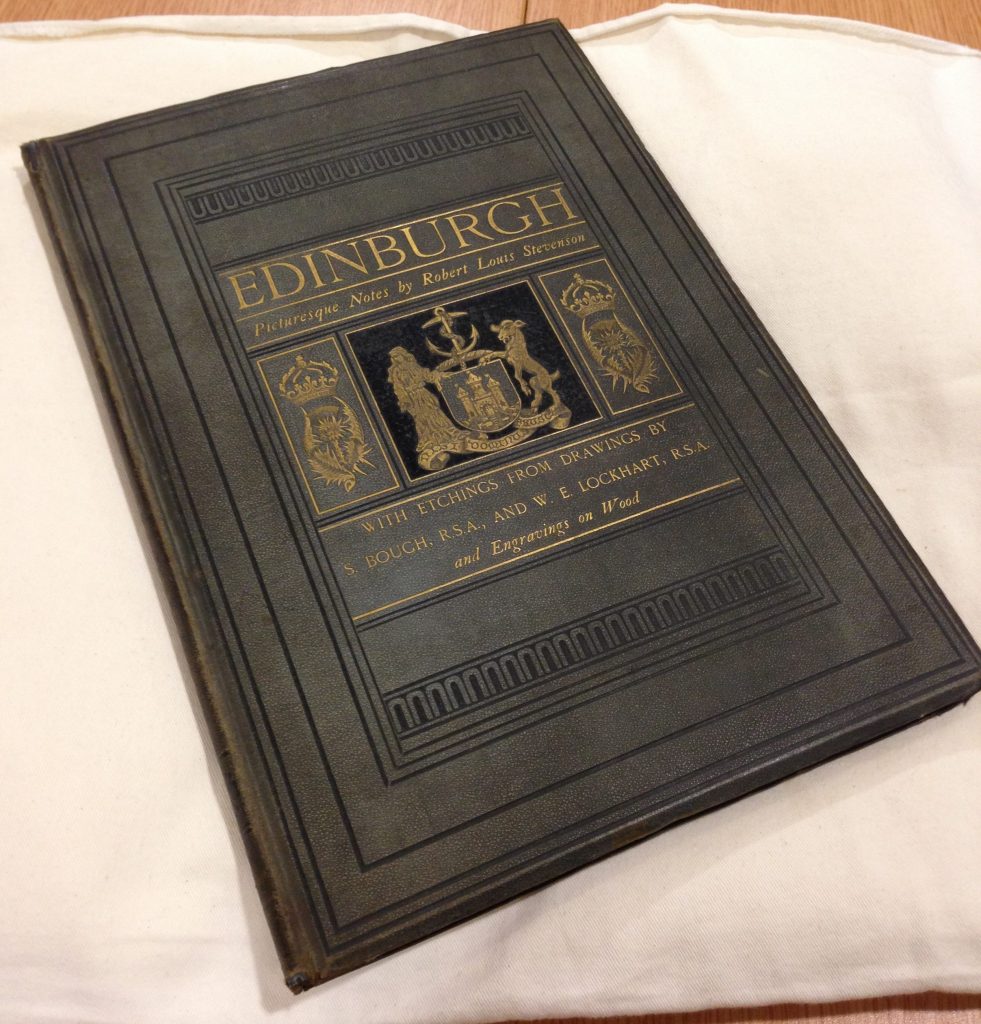
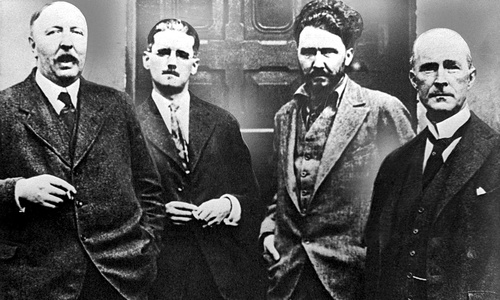


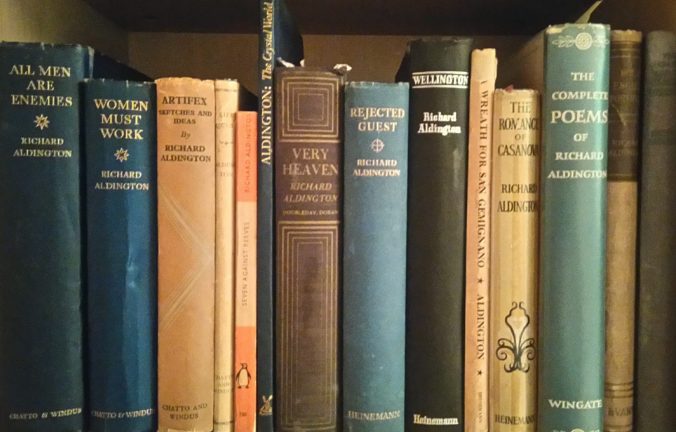




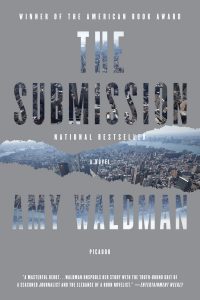

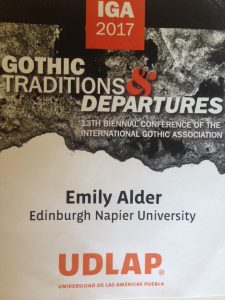 I have been a member of this Association for ten years and this was my fifth conference. It’s always a pleasure to see old friends and familiar faces as well as getting to know the many fascinating new people I inevitably meet at events like this.
I have been a member of this Association for ten years and this was my fifth conference. It’s always a pleasure to see old friends and familiar faces as well as getting to know the many fascinating new people I inevitably meet at events like this.
